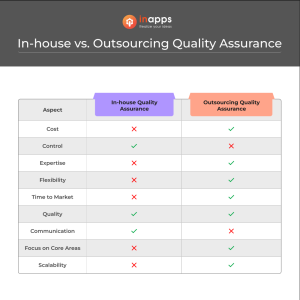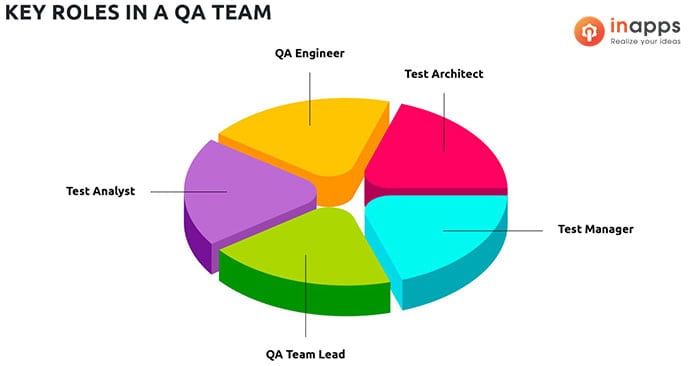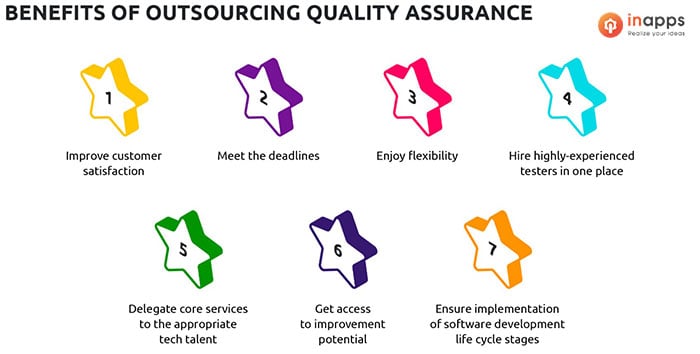- Home
- >
- Offshore News
- >
- Why Outsourcing Quality Assurance And How To Do It Right
1. Comparison of In-house vs. Outsourcing Quality Assurance
It’s hard to choose between in-house quality assurance and outsourced QA services as one wrong move can make or break your goal. For first-time decision-makers, this can feel far more daunting. However, both the in-house QA team and outsourced QA team cater to different needs and requirements.

The following comparison evaluates crucial aspects like cost, control, scalability, and communication between the two, offering insights to guide your decision.
Cost
- In-house QA Team: Maintaining an in-house team often entails higher costs due to salaries, training, equipment, and infrastructure. The upfront and ongoing expenses can be significant.
- Outsourced QA Team: Outsourcing quality assurance can lead to cost savings. Companies benefit from reduced overhead and can leverage the cost efficiencies of their partners, who might have economies of scale or lower cost bases due to their location.
Control
- In-house QA Team: Companies enjoy greater control over in-house teams. They can directly oversee projects, tailor processes, and quickly adjust to changing needs.
- Outsourced QA Team: Control over outsourced teams is less direct. Companies must rely on contractual agreements and effective communication to guide the QA process, which can sometimes lead to challenges in alignment.
Scalability
- In-house QA Team: Scaling an in-house team can be slow and costly, requiring recruitment, training, and additional resources.
- Outsourced QA Team: Outsourced QA teams offer high flexibility. Companies can scale their QA efforts up or down quickly, depending on project needs, without long-term commitments.
Communication
- In-house QA Team: Communication is more straightforward, with opportunities for immediate feedback and adjustments.
- Outsourced QA Team: Communication with outsourced teams can be challenged by time zone differences, language barriers, and cultural differences, requiring more structured processes to ensure clarity and alignment.
Focus on Core Areas
- In-house QA Team: Managing an in-house QA team requires significant resources, which might divert attention from core business activities.
- Outsourced QA Team: Outsourcing quality assurance allows companies to concentrate on their primary development and innovation activities, potentially leading to greater business growth and product innovation.
QA Tester is the general term for different roles in software QA outsourcing. They are the people who check everything in the software to make sure it works right. This group includes many experts like QA engineers, test analysts, test architects, test managers, and QA team leads.
In an outsourced quality assurance team, each role plays a critical part in ensuring that the software you get is of the best quality, free from bugs, and works well. Here’s a closer look at these roles:
QA Engineer
A QA engineer is the one who tests the software to find any mistakes and make sure it meets the high-quality standards we expect. They work closely with the people who make the software to fix any issues they find.
Test Architect
The test architect is the master planner who designs the testing world. They come up with the best ways to test the software, making sure we can find bugs efficiently without wasting time. They know a lot about the software and figure out smart ways to test it.
Test Analyst
A test analyst handles the paperwork side of testing. They pick what parts of the software need to be checked and keep detailed notes on the testing results. Their work helps make testing faster by using computers to repeat tests automatically. They also make sure to tell everyone involved how the testing went.
Test Manager
The test manager is like the captain of the ship, steering the testing project towards success. They watch over the testing process and decide what everyone should work on. They keep the testing on track and make sure all the team’s efforts are focused on making the software the best it can be.
QA Team Lead
Lastly, the QA team lead is in charge of the team. They hire new people, do interviews, and sometimes jump in to help with the testing. But mostly, they make sure everyone is moving forward together and that the team works well as a unit.

Key Roles in Most QA Teams
4. Quality Assurance Outsourcing Services
4.1 Manual QA Testing
Manual testing involves human testers executing test cases without the use of automation tools. Instead of using fancy tools or machines, a human tester clicks around the software, looking for any problems or bugs. This approach is good because humans can think creatively and catch things that automated tools might miss, like if a button is hard to find or if something just doesn’t feel right when you use it.
But, it can also take a lot of time because someone has to do all the clicking and checking themselves, which means it might not be the best option for big, complex software projects where there’s a lot to test.
4.2 Automated QA Testing
Automated testing involves using software tools and scripts to execute predefined test cases. This can be really fast and efficient because the computer can do the same tests over and over again without getting tired. It’s great for checking things like if a website still works after a change or if a new feature hasn’t broken anything old.
But setting up these tests can take a bit of work at first, and sometimes they might miss things that only a human would notice, like if something just doesn’t look right on the screen.

Two types of QA testing
4.3 Hybrid QA Testing
In practice, many organizations adopt a hybrid approach that combines both manual and automated testing to leverage the strengths of each method. Manual testing can be used for exploratory testing, usability testing, and ad-hoc testing. Automated testing can be applied to regression testing, performance testing, and API testing.
By combining manual and automated testing, teams can achieve comprehensive test coverage and improve the overall quality of software products.
5. Outsourcing Quality Assurance Cooperation Models
4.1 A dedicated team of software testing experts
A dedicated team cooperation model is suitable for you if you are looking to hire a team of software testers that will be integrated with your in-house team. Companies choose this model in case they have a fully operational software development team, but need to outsource QA services for their project’s success.
4.2 Staff Augmentation
In this quality control outsourcing model, you can hire individuals or small groups of experts from an outsourcing company. These experts become part of your team, and you manage them directly. It’s like borrowing a few super-smart people to fill in the gaps in your team. This works well when you only need a few extra hands and not a whole team.
6. Top Outsourcing Quality Assurance Companies
InApps Technology
Founded in 2016, InApps is a software outsourcing and QA testing company with more than 8 years of experience in the market. Awarded by Clutch in Vietnam and Southeast Asia for exceptional quality and customer satisfaction, InApps has steadily grown into a trusted partner for businesses worldwide. They boast over 200 successful projects, a remarkable 98% customer satisfaction rate, and a team of over 100 in-house talents. Their services encompass manual testing, automated testing, performance testing, and security testing.
With a focus on edtech, healthcare, e-commerce, fintech, and more, InApps delivers customized QA solutions to address specific business challenges. Whether you want a single QA engineer or an entire team of software testers, InApps will satisfy your needs. By choosing one of their QA packages, you will be sure that your project will be thoroughly tested and debugged.
Utor Team – Remove bottlenecks with outsourced QA testing
The next top outsourcing quality assurance company is Utor Team. With over 6 years of experience, an impressive satisfaction rate of 4.8 and over 150 positive reviews on listing platforms, Utor team has 60+ skilled testers and engineers, to help you succeed. They’ve completed over 46 projects and set up more than 60 QA departments from scratch, earning us recognition as one of the best software testing outsourcing companies.
TP&P
TP&P Technology is a leading software development company specializing in software development, IT consulting, and outsourcing quality assurance testing.
Their QA testing services are
- Functional Testing: Thorough testing of software functionalities to ensure they meet specified requirements.
- Performance Testing: Evaluation of system performance under various conditions to identify and address potential bottlenecks.
- Mobile App Testing: Testing of mobile applications across different devices and platforms to ensure optimal performance and user experience.
- Web App Testing: They make sure your web applications operate smoothly across all browsers and devices as expected. Their QA testing team will check the application functions, and evaluate its interface with different web browsers to provide you with the highest quality product.
ScienceSoft – Enjoy quality software thanks to QA outsourcing
ScienceSoft excels in testing thanks to its experienced team of over 75 QA professionals. Plus, they’re certified by the International Software Testing Qualifications Board (ISTQB), meaning they follow top-notch testing practices. ScienceSoft’s teams are also great at managing themselves, making sure testing happens smoothly and any issues get sorted fast.
They’ve got a quality management system certified by ISO 9001, and when it comes to keeping your info safe, ScienceSoft has you covered with their ISO 27001-approved security system. They use modern tech and have expert staff to ensure your data stays secure. Plus, they’re flexible with different testing methods like Waterfall, Agile, and more, making sure they fit your needs perfectly.
QASource – Deliver Quality Control Outsourcing On Time
QASource is a leading provider of outsourcing quality assurance and software testing services. With a reputation for excellence, QASource collaborates with a wide range of partners, such as Amazon, Adobe, IBM, Oracle, etc. Their services include:
- API Testing Services
- Artificial Intelligence Testing Services
- Automation Testing Services
- Blockchain Testing Services
- Cloud-based Application Testing Services
>> Read next: WHEN DO YOU NEED TO HIRE A PROFESSIONAL SOFTWARE QA TEAM?
Let’s create the next big thing together!
Coming together is a beginning. Keeping together is progress. Working together is success.





















